#Indo-Pacific Nations
Text
World: The West Isn't Buying Into China's Year of Diplomacy

Chinese President Xi Jinping at a press conference in Shaanxi, on May 19, 2023. A new poll indicates that the West does not believe that China is contributing to Global Security. Florence Lo/Pool/AFP Via Getty Images
Western nations increasingly see China as an interventionist power that is not improving global security, according to recent polling, as Beijing struggles to square its desired peacemaker image with the political realities of its expanding global influence.
The Pew Research Center conducted a 30,000-person survey across 24 nations between February and May and found that people living in European, North American and Indo-Pacific democracies are particularly wary of China's influence. The sentiment was less strong, though still present, among African and South American respondents.
A median of 71 percent of the 30,000 people polled felt that China does not contribute either much or at all to international peace and stability, versus 23 percent who felt China does. Americans (80 percent), Dutch (86 percent), British (80 percent), Germans (80 percent), and French (75 percent) were among those who felt most strongly that Beijing is a negative influence on global affairs.
Democratic Indo-Pacific nations emphatically agreed, with 87 percent of South Koreans, 85 percent of Australians, and 85 percent of Japanese feeling the same.
The list of nations—the United States, Canada, France, Germany, Greece, Italy, Japan, Netherlands, South Korea, Spain, Sweden, the United Kingdom, Argentina, Brazil, Hungary, India, Indonesia, Israel, Kenya, Mexico, Nigeria, Poland and South Africa, and Australia—is dominated by Western liberal democracies, with inherent ideological tensions likely somewhat explaining the negative views of Chinese foreign influence.
But only in Indonesia, Kenya and Nigeria did a majority of respondents say Beijing contributes either a fair amount or a great deal to international peace and stability.
Newsweek reached out to the Chinese Foreign Ministry via email for comment.
China—already considered by many an economic and technological superpower—is still shaping its military and diplomatic clout abroad. Major decades-long investment in the former is openly intended to eventually challenge American hegemony, but on the diplomatic battlefield, Beijing is following a less publicly combative path.
Among the salient diplomatic issues that have helped shape global opinions of China this year are one striking success and one ongoing failure.
The former was the landmark Iran-Saudi Arabia normalization deal signed in April, in which China unexpectedly brokered a détente few thought likely given the deep and historic animosity between the Middle East's power players.
But China's unconvincing neutrality regarding Russia's war on Ukraine has somewhat eroded global trust in Beijing, particularly among the Euro-Atlantic and Indo-Pacific nations rallying to Kyiv's cause. China's de facto backing for Russia has undermined its continued calls for peace and the anemic peace plan it proposed in March.
North vs. South
Larger issues involving China—among them the fate of Taiwan, the situation in the South China Sea, lingering frustrations about the pandemic, the brewing showdown with the U.S., human rights, and concerns about political interference—have "completely dwarfed" Beijing's diplomatic efforts, Andrew Small, a senior transatlantic fellow at the German Marshall Fund, told Newsweek.
"Publics have evidently not seen either the Saudi-Iranian deal as particularly significant or the Chinese efforts on Ukraine as particularly credible," Small said.
Small noted Beijing will not necessarily be too concerned with continued Western skepticism.
"In one sense, the argument for what China has been trying to do on Ukraine and in some of these other efforts was positioning in the 'Global South,'" he said. "The view on their side had been that no one in Europe is going to take this seriously, but they are able to position themselves through this in the Global South as an actor that approaches these issues in a neutral way."
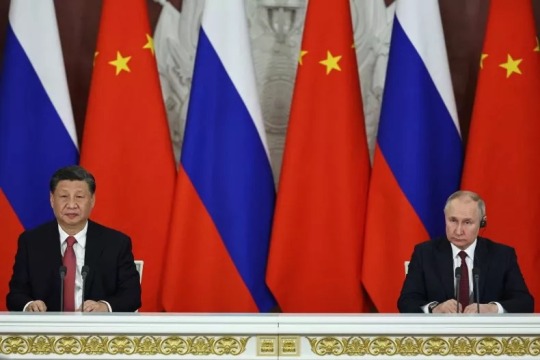
Russian President Vladimir Putin (R) and China's President Xi Jinping deliver a joint statement in Moscow, on March 21, 2023. China's de facto support of Russia's war on Ukraine has angered Western nations. Mikhail Tereshchenko/Sputnik/AFP Via Getty Images
But the poll's findings also suggest that Beijing's self-framing might not be playing out as it hoped. A median of 57 percent of those surveyed said they felt China interferes in other countries affairs either a fair amount or a great deal.
The sentiment was most notable in Europe, where a majority of national respondents excluding Hungarians agreed, as well as in North America. A majority of all those in Indo-Pacific nations apart from Indonesia saw Beijing as interventionist.
Even in the four of the six African and South American nations surveyed a majority said China intervened at least somewhat in other countries' affairs. Fifty percent of South Africans and 46 percent of Argentinians also agreed.
"It's such a mantra in Chinese foreign policy, so foundational in the way that they frame things that this is not what they do, and it is the antithesis of the Western approach," Small said.
Against this backdrop, Small added, it is "striking" to see so many nations feeling that China is indeed intervening abroad. The data suggests, he said, that the perception of Chinese anti-interventionism is being "shredded."
Recent months have seen a renewed China-U.S. effort to thaw chilly bilateral relations. In June, Secretary of State Antony Blinken visited Beijing to meet with Chinese President Xi Jinping. And earlier this week, Blinken told CNN the U.S. wants to "put some stability into the relationship."
But the long-term disputes show no signs of easing. While visiting Tonga this week, Blinken hit out at what he called China's "increasingly problematic behavior" in the Indo-Pacific.
In Europe too, major nations are increasingly concerned about Chinese espionage and influence, even if leaders like French President Emmanuel Macron and German Chancellor Olaf Scholz are still courting investment.
Worsening Euro-Atlantic ties with Beijing, Small said, might accelerate a brewing confrontation.
"To a certain extent, this will validate an analysis on the Chinese side that starts to write off the West," he said, and instead focus on a "winnable" public opinion battle in the developing world.
— Newsweek Magazine | By David Brennan | July 27th, 2023
#World#China 🇨🇳#Diplomacy#Western Nations#Peacemaker Image#Beijing#Global Influence#China's Influence#Americans 🇺🇸 Dutch 🇳🇱 British 🇬🇧 Germans 🇩🇪 French 🇫🇷#Iran 🇮🇷 Saudi Arabia 🇸🇦#Russia 🇷🇺 Ukraine 🇺🇦#Taiwan 🇹🇼#South China Sea#Andrew Small#German Marshall Fund#Global South#Europe 🇪🇺#North America#Indo-Pacific Nations#South Africans#China🇨🇳 | U.S. 🇺🇸#Secretary of State Antony Blinken#Tonga 🇹🇴#Chinese President Xi Jinping#French President Emmanuel Macron#German Chancellor Olaf Scholz#Euro-Atlantic#Developing World
0 notes
Photo

Gray reef sharks, common in the Indo-Pacific region, feed on short-nosed unicornfish.
PHOTOGRAPH BY LAURENT BALLESTA, NAT GEO IMAGE COLLECTION
#laurent ballesta#photographer#national geographic#gray reef sharks#sharks#animal#indo-pacific regtion#short-nosed unicornfish#nature
34 notes
·
View notes
Text
India: The Emerging Global Hub for Manufacturing, Maintenance, and Logistics
Imagine a world where India isn’t just the land of vibrant cultures, ancient history, and spicy curry but also the backbone of global manufacturing, maintenance, and logistics. This vision is rapidly becoming a reality, transforming India’s role in the global economy and military alliances. As this transformation unfolds, the implications are profound, setting the stage for India to become an…
#2024#aerospace industry#allied nations#armed forces#defense sector#digital transformation#diplomatic ties#economic development#economic growth#geopolitical significance#global hub#Global Supply Chain#India#Indo-Pacific#industrial corridors#infrastructure#international partnerships#Logistics#maintenance#Make in India#Manufacturing#maritime services#non-alignment#QUAD#regional-security#repairs#skilled labor#strategic location#Strategic-Alliances#technological advancements
0 notes
Text
youtube
#youtube#militarytraining#National Security#Leadership#International Relations#Strategy#Diplomacy#Military#Symposium#Senior Leaders#US Navy#US Army#Security#US Military#US Air Force#Indo-Pacific Strategy#US Coast Guard#Global Affairs#US Marines#Indo-Pacific Region#Defense#Marine Corps#Panel Discussions#Partnership#Seoul#South Korea#Peace#USMC#Alliance#Marines
0 notes
Text
#Hong Kong#China#Hong Kong national security law#Hong Kong Basic Law#Article 23#politics#sanctions#USA#human rights#political repression#Hong Kong Sanctions Act#US House Committee on the Indo-Pacific#nationalism#autonomy#Sand News#Education Bureau#education#propaganda#Hong Kong Alliance in Support of Patriotic Democratic Movements of China#University of Hong Kong#Hong Kong Free Press#news
0 notes
Text
Hey everyone, France says it doesn’t like “imperialism” in the Indo-Pacific.


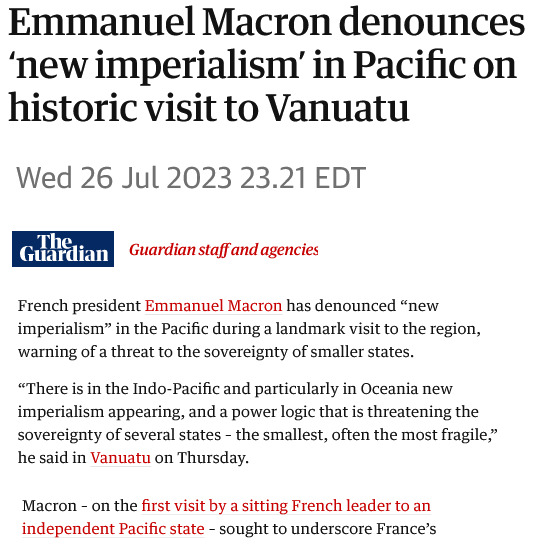
French president: “There is in the Indo-Pacific and particularly in Oceania new imperialism appearing, and a power logic that is threatening the sovereignty of several states - the smallest, often the most fragile.”

Some stuff.
“Thanks to its overseas territories, France has an exclusive economic zone of nearly 11.7 million square kilometers, 93 percent of which is in the Indo-Pacific”:

"French military presence” in the Indo-Pacific:

Areas of Pacific and Indian oceans actively patrolled/monitored by French forces:
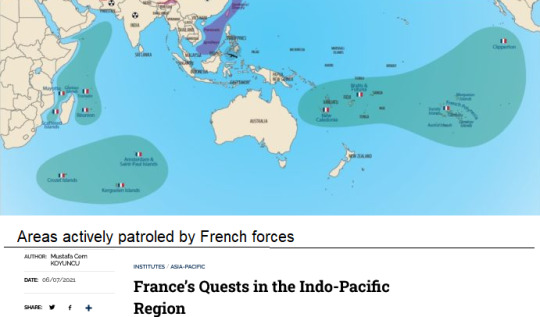
Tahiti and much of Polynesia?

French military presence in Africa:

Nations obligated to use the notorious CFA franc, subject to imposed debt conditions and French-directed investment and lending:

From July 2023, “President Macron reaffirms French ownership of New Caledonia” (one of the largest islands in the South Pacific, where in recent years Indigenous Kanak people have advocated for independence from France):


Overseas departments of France in the Indian Ocean (places still officially/formally administered by -- “part of” -- France):

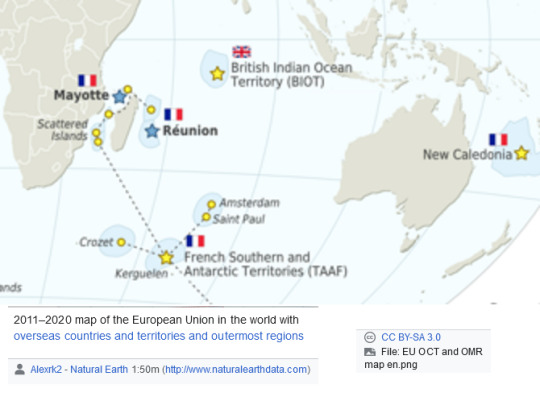
Look at some of the recent dates of “independence” for these French colonies:

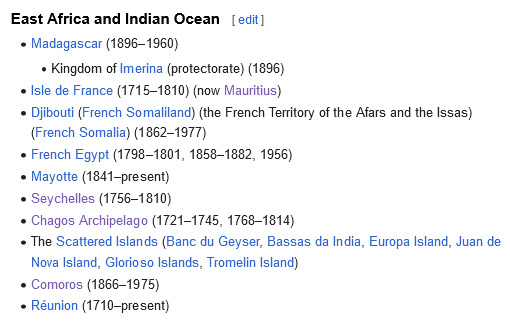

“From 1966 to 1996, France carried out 193 nuclear tests in the South Pacific”:

“France’s exclusive economic zones”:
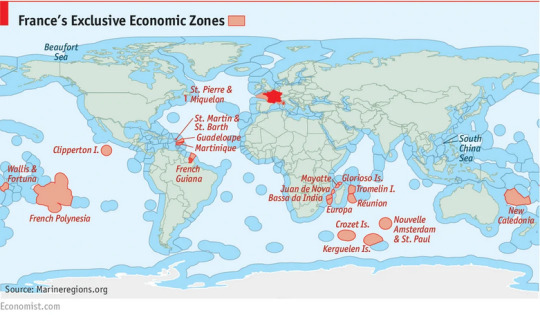
“French military presence in the Indo-Pacific”:


3K notes
·
View notes
Text
In Honor of National Crab Day, Behold the Candy Crab 🦀 🦀 🦀!









The candy crab (Hoplophrys oatesi) is a small but stunning crustacean that lives on soft corals in the Indo-Pacific region
It hides itself by mimicking the colors of the coral it takes refuge in. The candy crab will even attach polyps to its carapace for added camouflage
Their colors vary depending on the color of the coral they hide in so they can be white, pink, yellow or red
Love to sea it 🌊
#crab day#marine biology#marine science#science#biology#crabs#crab#crustacean nation#crustacean#national crab day#candy crab#marine life#oceanography#love to sea it#marine creatures#ocean life#sea animals#sea creatures#naturecore#sea critters#ocean animals#sea life#marine animals#ocean#crablr#aquatic life#underwater#ocean creatures#crustaceans#photography
194 notes
·
View notes
Text
14 Aug 23
With the deadline for residents to weigh in on the proposed 360-degree missile defense system for Guam passing Friday, demonstrators gathered at the Chief Kepuha Park roundabout in Hagåtña for a protest for peace.
Members of activist group Prutehi Litekyan: Save Ritidan and Independent Guåhan, as well as other concerned citizens, stood along the roadside holding signs emblazoned with the slogans "No war for Guåhan," "Defend the sacred!" and "No more imperialist war games" as the evening traffic rush ramped up.[...]
Beyond raising concerns regarding the environment, natural and cultural resources, and land that the group has raised with previous military construction projects, Flores said she doesn't believe the system will bring more security for Guam.
"It's really important that we ask ourselves what genuine security means," she said. "It ... definitely means more than national security. It means having clean water, living in our homeland without the risk of war ... and we feel that the missile defense system definitely makes us a bigger target for war."
Though the system is being sold as a way to protect Guam, its purpose is to help use Guam as a base for the U.S. military to project force and protect the nation, she said.[...]
U.S. Indo-Pacific Command has called the Guam Defense System the top national defense priority for the region.
19 Aug 23
461 notes
·
View notes
Text
Seal Team 6, the clandestine US Navy commando unit that killed Osama bin Laden in 2011, has been training for missions to help Taiwan if it is invaded by China, according to people familiar with the preparations. [...]
CIA director Bill Burns told the Financial Times last week that 20 per cent of his budget was devoted to China, a 200 per cent rise over three years. [...] “With the Pentagon’s reorientation over the past few years to focus on great power competition, it was inevitable that even the nation’s most elite counterterrorism units would seek out roles in that arena, for that path leads to relevance, missions and money[.]” [...]
Admiral Samuel Paparo, head of US Indo-Pacific command, recently warned that the US military would turn the Taiwan Strait, which separates Taiwan from China, into an “unmanned hellscape” if Beijing were about to attack. He said doing so would involve unmanned submarines, ships and drones to make it much harder for the PLA to launch an invasion.

43 notes
·
View notes
Text
Right now is the time to get involved in the defeat of America's most dangerous enemy since the Cold War.
The traditional election season, starting on Labor Day, is a thing of the distant political past. And considering the magnitude of the threat to democracy, even waiting for the end of the primary season may be too late.
The worst president in our history is, arguably, stronger within the leadership ranks of the Republican Party than he has ever been. He is now the most dangerous presidential candidate in U.S. history. As a consequence, the great question before the rest of us is whether enough of us are ready to do whatever is necessary to defeat this threat as we have all those that have come before.
Sadly, there is reason to believe that this time we may not meet the challenge. Right now, Donald Trump is one of two people who could be our next president. The race, at the moment, between him and President Joe Biden, is too close to call.
The people with their heads up their ass over Biden's age are either hypocrites or dissemblers. On Inauguration Day 2025, Donald Trump will be 95.66% of Joe Biden's age. And Trump will also be older in January of 2025 than Biden was upon assuming office in 2021. Biden may have a lifelong stutter but he is still grounded in reality in a way the narcissistic nepo baby Donald Trump never was.
Joe Biden by any objective metric has been one of the most successful presidents in modern U.S. history. He has led the creation of more major legislative initiatives benefiting the American people than any president in 60 years. He oversaw the creation of more than 14 million jobs during his first three years in office. He has brought down inflation and reduced the prices of vital medicines to affordable levels. He has restored American leadership worldwide, expanded our vital alliances like NATO, and stood up to our enemies. All presidents face challenges and make missteps. But it is hard to deny that in the wake of the U.S. economic recovery, the passage of the American Rescue Plan, the Bipartisan Infrastructure Bill, the CHIPs and Science Act, and the Inflation Reduction Act, the expansion of NATO, and the creation of new Indo-Pacific alliances, Biden’s record is formidable.
That a president with this record is in a horse race with a candidate who is a menace to the country, who led an insurrection, who is a pathological liar whom courts have found to be a fraud and a rapist, and who has no real ideas, no credible policy proposals, no record of actually ever achieving anything for the American people is chilling.
In normal times, over 40% of US voters would NOT pick a notorious sex offender for president. But these are not normal times.
You would have thought that the sight of mobs carrying Trump flags and weapons and chanting for the death of Vice President Mike Pence on January 6, 2021, would have been alarm enough. You would have thought the same of Trump’s Access Hollywood tape, in which he confessed his impulse to abuse women. You would have thought the two dozen women who accused him of abuse would have had that effect. Even if none of those things were quite warning enough, you would have thought the findings in the E. Jean Carroll case would have been enough. After all, respected federal judge Lew Kaplan wrote, “The fact that Mr. Trump sexually abused—indeed, raped—Ms. Carroll has been conclusively established and is binding in this case.”
It should have been enough. But so far, it has not been.
And who would have thought that the party of Ronald Reagan is now led by a stooge of the Evil Empire?
You would have thought that Trump reaching out on national television to our Russian adversaries for aid during the 2016 campaign would have been enough. You would have thought the conclusive findings of every major U.S. intelligence agency that Russia sought to aid Trump’s campaign would have been enough. You would have thought that Robert Mueller’s finding 10 instances of possible obstruction of justice by Trump would have been enough. You would have thought Trump kowtowing to Vladimir Putin and taking his word over that of our intelligence and law enforcement communities would have been enough. You would have thought his illegally withholding aid to Ukraine to seek dirt on Joe Biden would have been enough. You would have thought his impeachment for that would have been enough.
Are you willing to spend more time and money than in previous election cycles to end a major threat to Western democracy and to undermine homegrown fascism for at least the rest of this decade?
So, ask yourself, is that enough to make you do more than you have done? Is that enough to commit for the next 10 months to do more than you have ever done during an election year? To give more? To canvas more? To spread the word more? To help get voters to the polls? To ensure every member of your family, your friends, your co-workers do the same? The stakes are too high to do less than everything you can.
I rarely quote Margaret Thatcher and would probably disagree with at least 90% of her views. But she did know something about winning elections and combating the USSR. If she was good for just one thing, it's for this observation in a speech made in her retirement.
[N]o battles are ever finally won; you have to go on winning them by example and by being prepared to defend your way of life against those who would attack it.
If we learn just one thing from the Trump threat, it's that we can never rest on our past laurels. A slacker democracy is one which will not outlast a determined demagogue.
Civic involvement by pro-democracy citizens is absolutely necessary to maintain freedom.
#democracy#threat to democracy#donald trump#democracy vs. totalitarianism#trump is a tool of russia#trump is a sex offender#if you hate freedom vote for trump#register and vote#vote blue no matter who#support democratic candidates#the biden administration's economic growth programs#civic involvement#david rothkopf#bernard l. schwartz#election 2024
62 notes
·
View notes
Text

LETTERS FROM AN AMERICAN
July 23, 2024
HEATHER COX RICHARDSON
JUL 24, 2024
Vice President Kamala Harris continues her momentum toward the 2024 presidential election since President Joe Biden’s surprise announcement on Sunday that he would not accept the 2024 Democratic presidential nomination.
Today more than 350 national security leaders endorsed Harris for president, noting that if elected president, “she would enter that office with more significant national security experience than the four Presidents prior to President Biden.” As vice president, she “has met with more than 150 world leaders and traveled to 21 countries,” the authors wrote, and they called out her work across the globe from her work strengthening partnerships in the Indo-Pacific region to her historic trip to Africa and her efforts to expand U.S. relationships with nations in the Caribbean and North Central America. In contrast to Harris, the letter said, “Trump is a threat to America’s national security.”
Those signing the letter included former Central Intelligence Agency director Michael Hayden, former director of national intelligence James Clapper, national security advisors Susan Rice and Thomas Donilon, former secretaries of defense Chuck Hagel and Leon Panetta, and former secretaries of state Hillary Clinton and John Kerry.
In a New York Times op-ed today, former secretary of state Clinton praised Biden for his “decision to end his campaign,” which she called “as pure an act of patriotism as I have seen in my lifetime.” She went on to say that Vice President Harris “represents a fresh start for American politics,” offering a vision of an America with its best days ahead of it and, rather than “old grievances,” “new solutions.”
Clinton noted that her own political campaigns had seen her burned in effigy, but said, “It is a trap to believe that progress is impossible” and that Americans cannot overcome sexism and racism. After all, she pointed out, voters elected Black American Barack Obama in 2008, and she herself won the popular vote in 2016. “[A]bortion bans and attacks on democracy are galvanizing women voters like never before,” Clinton wrote, and “[w]ith Ms. Harris at the top of the ticket leading the way, this movement may become an unstoppable wave.”
Today, Harris held her first campaign rally, speaking to supporters in Milwaukee, Wisconsin, where the Republicans held their national convention just last week. The energy from the 3000 people packed into the gym where she walked out to Beyoncé’s song “Freedom” was palpable.
She began by thanking Biden and touting his record, then turned to noting that in her past as a prosecutor, California attorney general, U.S. senator from California, and vice president, she “took on perpetrators of all kinds—predators who abused women, fraudsters who ripped off consumers, cheaters who broke the rules for their own gain. So,” she said, “hear me when I say: I know Donald Trump’s type.” She went on to remind the audience that Trump ran a for-profit college that scammed students, was found liable for committing sexual abuse, and “was just found guilty of fraud on 34 counts.”
While Trump is relying on “billionaires and big corporations,” she said, “we are running a people-powered campaign” and “will be a people-first presidency.” The Democrats, she said, “believe in a future where every person has the opportunity not just to get by but to get ahead; a future where no child has to grow up in poverty; where every worker has the freedom to join a union; where every person has affordable health care, affordable childcare, and paid family leave. We believe in a future where every senior can retire with dignity.”
“[A]ll of this is to say,” she continued, “Building up the middle class will be a defining goal of my presidency. Because…when our middle class is strong, America is strong.”
In contrast, she said, Trump wants to take the country backward. She warned that he and his Project 2025 will “weaken the middle class,” cutting Social Security and Medicare and giving “tax breaks to billionaires and big corporations,” while “working families foot the bill.” “They intend to end the Affordable Care Act,” she said, “and take us back…to a time when insurance companies had the power to deny people with preexisting conditions…. Remember what that was like? Children with asthma, women who survived breast cancer, grandparents with diabetes. America has tried these failed economic policies before, but we are not going back. We’re not going back.”
“[O]urs is a fight for the future,” she said “And it is a fight for freedom…. Generations of Americans before us led the fight for freedom. And now…the baton is in our hands.”
Meanwhile, MAGA Republicans are still scrambling for a plan of attack against Harris. One of their first angles has been the sexism and racism Clinton predicted, calling her “a DEI hire.” House Republican leaders have told fellow lawmakers to dial back the sexist and racist attacks.
MAGA Republican representative Andy Ogles (R-TN) has taken a different angle: he introduced an impeachment resolution against Harris, while others are demanding that the House should investigate Harris and demand the Cabinet remove President Biden under the 25th Amendment. The Republican National Committee has decided to make fun of Harris’s laugh.
But concern in the Trump camp showed today when Trump pollster Tony Fabrizio shared with reporters a “confidential memorandum” trying to get ahead of polls he says will show Harris leading Trump. He said he expects to see a “Harris Honeymoon” that will end quickly.
Trump has continued to post angrily on his social media feed but is otherwise sticking close to home. His lack of visibility highlights that the Republicans are now on the receiving end of the same age and coherence concerns they had used against Biden, and there might be more attention paid to Trump’s lapses now that Biden has stepped aside. CNN’s Kate Sullivan noted today, for example, that “Trump said he’d consider Jamie Dimon for Treasury secretary, but now says he doesn’t know who said that.”
As Tim Alberta noted Sunday in The Atlantic, the Trump campaign tapped J.D. Vance in an attempt to harden the Republican base, only to find now that he cannot bring to the ticket any of the new supporters they suddenly need.
According to Harry Enten of CNN, Vance is the first vice presidential pick since 1980 who has entered the race with a negative favorability rating: in his case, –6 points. Since 2000, the usual average is +19 points. Vance won his Senate seat in 2022 by +6 points in an election Republican governor Mike DeWine won by +25 points. Vance “was the worst performing Republican candidate in 2022 up and down the ballot in the state of Ohio,” Enten said. “The J.D. Vance pick makes no sense from a statistical polling perspective.”
Sarah Longwell of The Bulwark, who specializes in focus groups, noted that swing voters groups “simply do not like” Vance. “Both his flip flopping on Trump and his extreme abortion position are what breaks through,” she wrote.
The 2024 election is not consuming all of the political oxygen, even in this astonishing week. Today, the Federal Trade Commission (FTC) announced that eight large companies must turn over information about the data they collect about consumers, product sales, and how the surveillance the companies used affected consumer prices.
“Firms that harvest Americans’ personal data can put people’s privacy at risk. Now firms could be exploiting this vast trove of personal information to charge people higher prices,” FTC chair Lina M. Khan said. “Americans deserve to know whether businesses are using detailed consumer data to deploy surveillance pricing, and the FTC’s inquiry will shed light on this shadowy ecosystem of pricing middlemen.”
The eight companies are: Mastercard, Revionics, Bloomreach, JPMorgan Chase, Task Software, PROS, Accenture, and McKinsey & Co.
In the House, Republicans have been unable to pass the appropriations bills necessary to fund the 2025 U.S. budget, laced as they are with culture-wars poison pills the extremists demand. Today House members debated the appropriations bill for the Interior Department and the Environment which, among other things, bans the use of funds “to promote or advance critical race theory” or to require Covid-19 masks or vaccine mandates.
According to the European climate service Copernicus, last Sunday was the hottest day in recorded history. The MAGA Republicans’ appropriations bill for Interior and the Environment calls for more oil drilling, fewer regulations on pollutants, no new regulations on vehicles, rejecting Biden’s climate change executive orders, and reducing the funding for the Environmental Protection Agency by 20%.
LETTERS FROM AN AMERICAN
HEATHER COX RICHARDSON
#Letters from An American#Heather Cox Richardson#kamala harris#election 2024#surveillance pricing#the FTC#House GOP in disarray
20 notes
·
View notes
Text
India: The Emerging Global Hub for Manufacturing, Maintenance, and Logistics
Imagine a world where India isn’t just the land of vibrant cultures, ancient history, and spicy curry but also the backbone of global manufacturing, maintenance, and logistics. This vision is rapidly becoming a reality, transforming India’s role in the global economy and military alliances. As this transformation unfolds, the implications are profound, setting the stage for India to become an…
#2024#aerospace industry#allied nations#armed forces#defense sector#digital transformation#diplomatic ties#economic development#economic growth#geopolitical significance#global hub#Global Supply Chain#India#Indo-Pacific#industrial corridors#infrastructure#international partnerships#Logistics#maintenance#Make in India#Manufacturing#maritime services#non-alignment#QUAD#regional-security#repairs#skilled labor#strategic location#Strategic-Alliances#technological advancements
1 note
·
View note
Note
A few weeks ago, when we were having the Visa discussions, you said you suspected that the US military might have some role in securing whatever Harry's visa status is. With this Nigeria visit announcement coming from the Nigerian Dept of defence do you think that suspicion has more meat now? Last week Harry also did that random award announcing for a US army vet while wearing his medals. He seems to be doing a lot of these weird things lately, almost acting like an ambassador for the US army which is just so odd.
Why do you think the army is going with this? What's the basis for having a high profile foreign prince who served in the foreign army being a face of US military? Surely someone in the higher up ranks must find this odd and unsuitable.
The army, pretty much being an arm of the country's govt and security services (even if independent) does not need a face or a brand ambassador. Especially, when these gigs are more beneficial to the person acting important rather than the army itself.
What could Harry possibly bring to the table??
No, I don't think the US military had anything to do with the Nigeria visit. That was all exclusively Harry and Invictus Games / Archewell / whatever charity sponsored them. Largely because if the US military was involved, they'd have sent an American representative, not a British national living in the US.
I suspect why the US military is entertaining Harry may have to do with declining enlistment numbers. They may see him as someone who can help recruit younger generations. The military does do this from time to time - they get worried about declining enlistment so they get schemey and sometimes it works, sometimes it doesn't. Don't get me wrong; we still have a huge military, but the enlistment numbers today is a steep 40% drop from the enlistment numbers of the 1980s, and for an all-volunteer force, that's concerning.
It doesn't make any sense to me. The US military has never had celebrity ambassadors like this. They've always used their base commanders, flag officers, joint chiefs, secretaries, other politicians with a military background, etc. for that kind of recognition and acknowledgement. The celebrities are really only used for entertaining troops that are deployed to combat in USO tours (which Meghan participated in during her Suits days).
I know the US military is concerned about Russian, Chinese, and North Korean aggression in the Indo-Pacific but they wouldn't be partnering with an ex-prince to do their negotiations and contribute to their national defense strategy.
This is utterly bizarre and something I can't figure out. I have no idea what the US military's goal with this is.
25 notes
·
View notes
Text
13 notes
·
View notes
Text

Boeing Is Evaluating The F-15EX As Successor Of The EA-18G Growler
The new “Wild Weasel” variant of the F-15EX would make use of both existing capabilities of the aircraft, as well as new ones integrated from the Growler.
Stefano D'Urso
F-15EX Growler
An F-15EX Eagle II prepares to taxi for a training mission at Nellis Air Force Base, Nevada, Nov. 15, 2023. An upgraded version of the F-15 fourth-generation fighter jet, the F-15EX boasts a new electronic warfare system and an open mission systems architecture with advanced battle management systems. (U.S. Air Force photo by Airman 1st Class Elizabeth Tan)
As the production line of the F/A-18 is about to close, Boeing is studying whether the F-15EX Eagle II can be equipped to become the successor of the EA-18G Growler. The new “Wild Weasel” variant of the F-15EX would make use of both existing capabilities of the aircraft, as well as new ones integrated from the Growler.
“We are evaluating the technical feasibility of combining EA-18G-like capabilities with the F-15EX platform,” said Rob Novotny, Boeing’s executive director for Fighters Business Development. Novotny added that the study is still in the initial stage, but the company is already eyeing opportunities both for NATO members and the Indo-Pacific.
The move is due to the planned stop to the production of the F/A-18E/F Super Hornet in 2027, which in turn means the production of the EA-18G Growler will also end. On the other hand, the production of the Advanced Eagle is expected to continue for many years and leaves the door open to a new specialized variant for Electronic Warfare (EW).
“Modern aerial combat requires command of the electromagnetic spectrum, and this platform would lead the way into the next decade or two,” Novotny said. He also pointed out that the Eagle II offers several design advantages, including the aircraft’s range, speed, computing power and payload capacity.
F-15EX Growler

An F-15EX assigned to the 85th Test and Evaluation Squadron. (U.S. Air Force photo by 2nd Lt. Mary Begy)
One could argue that a low-observable, or stealth, aircraft like the F-35 could be better suited for the job, however Novotny mentioned that stealth shouldn’t be understood strictly in terms of low-observable coatings. In fact, similarly to the Growler, such capabilities could be also replicated by using advanced EW functions.
“Stealth means, to me, I can go to a place where the enemy doesn’t want me to go, and I can operate in their environment, achieve my objective, and not be targeted,” said Novotny.
The F-15EX is already equipped with advanced EW capabilities thanks to the Eagle Passive Active Warning Survivability System (EPAWSS), but it also has the ability to carry the AGM-88 High-Speed Anti-Radiation Missiles (HARMs). In addition to these, Boeing is exploring also the possibility to integrate the AGM-88G Advanced Anti-Radiation Guided Missile-Extended Range (AARGM-ER) and the Next Generation Jammer (NGJ) pods. Still, there’s no naval variant of the Eagle II, therefore, it looks like such a successor of the EA-18G could not operate from the flight deck of an aircraft carrier unlike the Growler.
U.S. Navy EA-18G Growlers assigned to the Electronic Attack Squadron 138 (VAQ-138) fly in formation over the Pacific Ocean, June 24, 2024. The EA-18G’s vast array of sensors and weapons provides the warfighter with a lethal and survivable weapon system to counter current and emerging threats. (U.S. Air Force photo by Senior Airman Tylir Meyer)
The F-15EX and the existing EW capabilities
The new F-15EX, developed from the F-15QA that was the most advanced Eagle variant, comes from a series of needs mainly emerged after the National Defense Strategy directed the U.S. armed services to adapt to the new threats from China and Russia. The aircraft, while extremely similar to the QA variant, features some US-only capabilities like the new AN/ALQ-250 Eagle Passive Active Warning Survivability System (EPAWSS) electronic warfare and electronic surveillance system and Open Mission Systems (OMS) architecture.
The F-15EX’s systems are powered by the Advanced Display Core Processor II, reportedly the fastest mission computer ever installed on a fighter jet, and the Operational Flight Program Suite 9.1X, a customized variant of the Suite 9 used on the F-15C and F-15E, designed to ensure full interoperability of the new aircraft with the “legacy Eagles”.
The F-15EX is equipped with the AN/APG-82(V)1 Active Electronically Scanned Array (AESA) radar, developed from the APG-63(V)3 AESA radar of the F-15C and the APG-79 AESA radar of the F/A-18E/F. This radar allows the Eagle II to simultaneously detect, identify and track multiple air and surface targets at longer ranges compared to mechanical radars, facilitating persistent target observation and information sharing for a better decision-making process.
EPAWSS, an US-only system that will be retrofitted also to the F-15E, provides full-spectrum EW capabilities, including radar warning, geolocation, situational awareness, and self-protection to the F-15. Because of this, the system enables freedom of maneuver and deeper penetration into battlespaces protected by modern integrated air defense systems.
F-15EX Growler
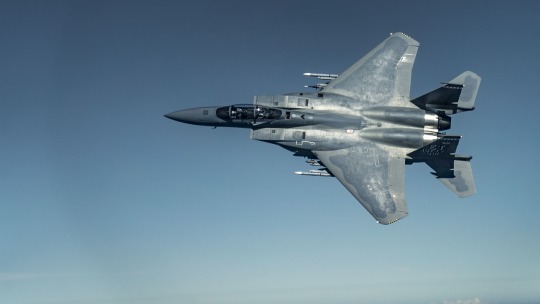
U.S. Air Force Lt. Col. Richard Turner, 40th Flight Test Squadron commander flies 40 FLTS Senior Enlisted Leader, MSgt Tristan McIntire during a test sortie in the F-15EX Eagle II over the Gulf of Mexico on Jun. 14, 2022. Assigned to the 96th Test Wing at Eglin Air Force Base, Fla., the F-15EX Eagle II is the Air Force’s newest 4th generation fighter being tested at the 40 FLTS. (U.S. Air Force photo by Tech. Sgt. John McRell)
EPAWSS is fully integrated with radar warning, geo-location and increased chaff and flare capability to detect and defeat surface and airborne threats in signal-dense and highly contested environments. The system is currently not integrated with the AN/AAR-57A(V) Common Missile Warning System (CMWS) designed to detect infrared threats, even if the F-15EX features the same mounting points used for these sensors on the F-15QA and F-15SA.
Chaff and flares capacity has been increased by 50%, with four more dispensers added in the EPAWSS fairings behind the tail fins (two for each fairing), for a total of 12 dispenser housing 360 cartridges. This improvement is important as in modern scenarios chaff and flares are often released preemptively to counter MANPADS (Man Portable Air Defense System), meaning that now the Eagle will have more countermeasures available for a better protection.
EPAWSS also integrates cognitive electronic warfare to better discriminate the signals received by the system. This capability was demonstrated during the Northern Edge 2023 large force exercise test event, which tested EPAWSS’ ability to rapidly respond to previously unencountered electromagnetic threats. The tests challenged the system’s ability to process in-mission sensor data, create exquisite techniques, and optimize waveforms in real time.
As for the kinetic capabilities, the F-15EX can carry the AGM-88 HARM on outboard wing stations 1 and 9. This capability is reportedly a product of the fly-by-wire upgrade funded by the Royal Saudi Air Force during the development of the F-15SA.

An F-15EX Eagle II from the 85th Test and Evaluation Squadron, 53rd Wing, takes flight out of Eglin Air Force Base, Florida, April 11, 2024, with U.S. Air Force Chief Master Sgt. David Wolfe, command chief of Air Combat Command, and Maj. Scott Addy, 85th Test and Evaluation Squadron, F-15 division chief. The F-15EX is the first Air Force aircraft to be tested and fielded from beginning to end, through combined developmental and operational tests. (U.S. Air Force photo by Capt. Lindsey Brewer)
The EA-18G and the capabilities it could pass to the F-15EX
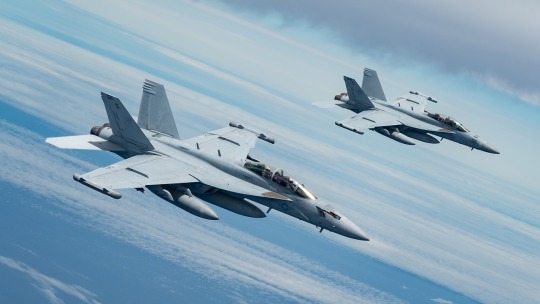
Based off of the F/A-18F, the Growler is a highly specialized Electronic Attack variant of the Super Hornet. The most noticeable difference with the baseline SH is the presence of the wingtip pods housing the ALQ-218 signals receiver suite, which helps to detect and geolocate emitters and signals.
The AN/ALQ-218 is a high performance RWR/ESM/ELINT system that allows the aircraft collect data about sources of radio frequency (RF) emissions: with this sensor, the EA-18G can “sniff” hostile radio signals to update the EOB (Electronic Order of Battle) of the combat theater where the aircraft is employed.
The EA-18G is equipped with an airborne electronic attack (AEA) avionics suite that has evolved from the EA-6B’s Improved Capability III (ICAP III) AEA system. In the future, with the Block II Growler upgrade and the NGJ (Next Generation Jamming) pods, the Growlers will also have Cyber Attack capabilities that will allow the EA-18Gs to “hack” or inject malware into enemy network.
The NGJ program aims to give the EA-18G fleet advanced airborne electronic attack capabilities through three frequency-focused increments – high-band, mid-band and low-band: in other words, the Growlers will replace the TJS pods operating in the 509 MHz to 18 GHz waveband, using three different pods, designated NGJ-LB (also known as Block/Increment 2), NGJ-MB (Capability Block/Increment 1), and NGJ-HB (Block/Increment 3) and directed specifically against the low- (100 MHz to 2 GHz waveband), mid- (2 GHz to 6 GHz), and high-band (6 GHz to 18 GHz) sections of the overall threat spectrum.
NGJ-MB is a high-capacity and power airborne electronic attack weapon system designed for the EA-18G electronic attack aircraft that was designed to carry out the usual job of denying, degrading and disrupting threat radars and communication devices, from an extended range and with enhanced ability than the previous AN/ALQ-99 tactical jamming pods, developed for the EA-6B Prowler.
The NGJ-MB, also known as the AN/ALQ-249(V)1 pod, uses directional emitters and AESA (active electronically scanned array) technology and an all-digital back end. It also has digital and software-based tech embedded in the design, which increases the ability to jam and allows for rapid beam steering and advanced jammer modulation.
While the NGJ-MB pod will “cover the majority of critical threats”, NGJ-LB will be extremely important to provide cover to stealth aircraft, threatened by the emerging counter-stealth Low Band radars, engaging enemy threats from increased stand-off distances and employing increased capacity (number of jamming assignments).
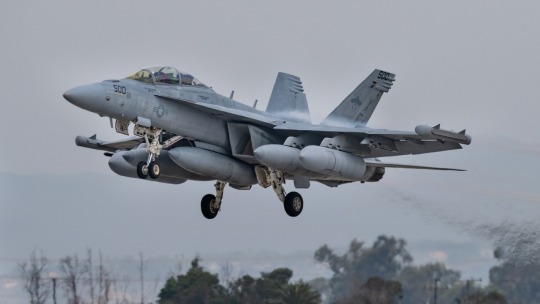
Loaded with external fuel tanks [and NGJ pods, ndr], an EA-18G Growler attached to the U.S. Navy’s Air Test and Evaluation Squadron Nine (VX-9) — the Vampires — goes airborne at Naval Base Ventura County Point Mugu in Southern California on Aug. 10, 2023, on its way to the adjacent Point Mugu Sea Range for a training exercise. The Growler is a two-seat variant of the carrier-based F/A-18 Super Hornet that is designed for electronic warfare. (U.S. Navy photo by Eric Parsons/Released)
NGJ-MB will replace one of high-band ALQ-99 pods that Growlers carry under each wing, while the NGJ-LB will replace the low-band pod that the aircraft carry on the centerline store position under the fuselage (the third one, a high-band pod, being developed as part of the so-called Increment III, will be carried on the left wing).
The Growler is also capable of carrying the HARM (High speed Anti-Radiation Missile) and AARGM (Advanced Anti-Radiation Guided Missile); these weapons are designed to seek out threat weapons systems and emitters, guiding on their energy, and destroy them. However, the EA-18G is expected to integrate also the new AARGM-ER.
The AARGM-ER is the evolution of the latest variant of the AGM-88 HARM (High-Speed Anti-Radiation Missile), the AGM-88E AARGM, a medium-range air-to-ground missile employed for Suppression and/or Destruction of Enemy Air Defenses (SEAD/DEAD). The AGM-88E is the result of a cooperative program with the Italian Air Force started in 2005 and developed as an upgrade and compliment to the AGM-88B/C. The AARGM program designed and produced a new Guidance Section and modified the existing Control Section, which are coupled with the legacy HARM Rocket Motor and Warhead Section, wings and fins.
The new Guidance Section features a passive anti-radiation homing receiver, satellite and inertial navigation system and a millimeter wave radar for terminal guidance, with the added ability to send images of the target via a satellite link before impact. The purpose of these new Guidance Section is to improve the effectiveness of the legacy HARM, especially against enemy radar and communications sites that would shut down to confuse incoming anti-radiation missiles (counter-shutdown capability) or pop-up threats.
As stated by the U.S. Navy, AARGM baseline capabilities include an expanded target set, counter-shutdown capability, advanced signals processing for improved detection and locating, geographic specificity providing aircrew the opportunity to define missile-impact zones and impact-avoidance zones, and a weapon impact-assessment broadcast capability providing for battle damage assessment cueing.
The AARGM-ER builds up on these capabilities to obtain an even more advanced weapon that is being integrated on the F/A-18E/F Super Hornet and EA-18G Growler and it is compatible for a future integration on all the variants of the F-35 Lightning II. The AARGM-ER combines the Guidance Section and Control Section of the AGM-88E with a new, larger rocket motor and a new warhead. The control surfaces have been redesigned too, obtaining aerodynamic strakes along the sides for increased lift and low-drag tail surfaces. The missile will reportedly have roughly double the range and speed of the AGM-88E.
About Stefano D'Urso
Stefano D'Urso is a freelance journalist and contributor to TheAviationist based in Lecce, Italy. A graduate in Industral Engineering he's also studying to achieve a Master Degree in Aerospace Engineering. Electronic Warfare, Loitering Munitions and OSINT techniques applied to the world of military operations and current conflicts are among his areas of expertise.
@TheAviationist.com
16 notes
·
View notes
Text
When Donald Trump first ran for the U.S. presidency in 2016, a wave of writing suggested that he was a realist. In this framing, Democratic Party candidate Hillary Clinton was presented as a neoconservative hawk who would start wars. Trump, by contrast, would balance U.S. commitments with its resources. He would avoid foreign conflicts and quagmires. He would be less ideological in his approach to nondemocratic states.
In 2024, this thinking has returned. Some realist voices are again suggesting that Trump is one of them. Trump’s desire to end the war in Ukraine—even though he simply intends to let Russia win—is taken as evidence of this. So is the selection of Ohio Sen. J.D. Vance as his vice presidential candidate. Vance has famously said that he does not care what happens to Ukraine. Conversely, he is a China hawk who seems to believe the United States cannot support both Taiwan and Ukraine simultaneously.
The notion that U.S. support for Taiwan and Ukraine is a trade-off is the most controversial component of the Trump realist position. Former Defense Department official Elbridge Colby, for example, has argued prominently that U.S. support for Ukraine undercuts its ability to help Taiwan, and that Europe should be almost exclusively responsible for helping Ukraine (or not).
But these hopes are badly misplaced. A second Trump term may well take an entirely different tack on China from the hawks—and even if he wants to move against Beijing, he lacks the discipline and ability to do so.
There is far more in Trump’s first term to suggest indiscipline, showboating, and influence-peddling than the clear-eyed, bloodless calculation of national interest that realists aspire to.
On China, Trump was undisciplined and sloppy. Yes, he turned against China in 2020, during the final year of his term, but that was more to deflect blame for COVID-19 than out of any realist or strategic reappraisal of U.S.-China relations. COVID-19 suddenly became the “kung flu” in Trump’s vernacular in an openly racist bid to change the subject.
Trump also undercut any ostensible focus on China by picking unnecessary fights with the United States’ regional partners. U.S.-South Korea and U.S.-Australia relations, for example, sank to their lowest point in years as Trump picked fights with their leaders because he wanted a payoff for the U.S. alliance guarantees.
Realism values allies for their ability to share burdens, project power, and generate global coalitions. Trump does not seem to grasp that at all. When Trump backed off his criticism of Japan, the turning point was apparently then-Prime Minister Shinzo Abe’s relentless flattery, including giving Trump a gold-plated golf club, rather than any strategic reevaluation by Trump or his team. Such frippery is exactly the opposite of the cold calculation that we associate with realism.
Trump also sank the Trans-Pacific Partnership (TPP) and all but dropped earlier U.S. rhetoric about a pivot or rebalance to Asia. Were China a threat that Trump took seriously, then building a tighter trade area among the United States’ Asian partners would be a smart move to pool local allied economic power and build patterns of administrative coordination among those partners. Indeed, that was the rationale behind TPP and the “pivot” to increased engagement in the Indo-Pacific when it was proposed by the Barack Obama administration. Trump did not see that, either; he is obsessed with imposing tariffs, even against allies, which violates the realist tenets that concern allied power accumulation and coordination against shared threats.
Finally, Trump’s admiration for Chinese President Xi Jinping’s autocracy was blatant, and Trump has once again recently praised Xi as his “good friend.” The former U.S. president has spoken approvingly of China’s crackdowns in Tiananmen Square, Xinjiang, and Hong Kong. He solicited Chinese help in the 2020 election, and China happily channeled money to Trump’s family and his properties during his presidency.
Trump clearly craves authoritarian powers at home and is happy to take China’s money. He was happy to pardon Republican lobbyist Elliott Broidy, who was convicted for illicitly acting on Beijing’s behalf. It stretches credulity to suggest that Trump will lead the United States, much less an Indo-Pacific coalition, in a major shift against a power that he admires. China will probably just throw money at him if he is reelected—especially after seeing his U-turn on a TikTok ban, a policy that he backed in his first term but failed to deliver on, after facing pressure from billionaire TikTok investor Jeff Yass.
Little else in Trump’s first term suggests s a thoughtful, realist weighing of priorities: Trump’s most important first-term foreign-policy venture was the attempted denuclearization of North Korea. Unsurprisingly, that effort was amateurish, sloppy, and unplanned—and it failed.
There is a realist argument for reaching out to Pyongyang. The United States’ long-standing policy of containment and deterrence has not changed North Korea, nor did it prevent its nuclearization. North Korea is now a direct nuclear threat to the U.S. mainland. A realistic foreign policy would accept that as an unchangeable fact and react to it. Perhaps a bold move by a risk-taking statesman could break the logjam.
Trump might have had the chance to pull this off, but he failed due to his own lack of discipline. Trump did not prepare for his meetings with North Korean dictator Kim Jong Un; instead, he simply walked off the plane and thought his New York tough guy shtick would somehow bowl over a man raised in the crucible of North Korea’s lethal family politics. There was no interagency process to build proposals ahead of time, nor any kind of realistic, measured deal that could have won over Pyongyang.
According to John Bolton, then Trump’s national security advisor, the president did not even read in preparation for the summits. Instead, Trump demanded the complete, verifiable, and irreversible nuclear disarmament of North Korea in exchange for sanctions removal, then walked out of the Hanoi summit when Pyongyang predictably rejected this wildly unbalanced so-called deal. Talks collapsed because Trump had not prepared and had no idea how to bargain on the issues when his first offer was rejected.
But Trump did get what he really wanted—lots and lots of publicity. His hugely hyped—and criminally underprepared—first summit with Kim in Singapore brought a week of nonstop news coverage. His later trip to the Demilitarized Zone, which included briefly walking inside North Korea, brought another wave of coverage. Trump even demanded that he receive the Nobel Peace Prize. This is showboating, not strategy.
The big issue in the realist case for Trump and Vance is that they will put Taiwan explicitly ahead of Ukraine in a ruthless prioritization of U.S. interests. As Andrew Byers and Randall Schweller write, Trump “understands the limits of American power.” From this perspective, the United States cannot reasonably hope to fight Russia and China simultaneously, much less a coordinated “axis” of those countries working with rogues such as Iran and North Korea. This notion is particularly connected with Vance, who has explicitly advocated abandoning Ukraine.
Yet Trump himself does not think this way. Trump’s supposed policy positions emerge on the fly as he speaks. He is lazy. He is not capable of the strategic thinking that realists want to attribute to him; one must only listen to his campaign speeches this year to see this. He routinely lies, makes up stories, and speaks in indecipherable word-salads. When Trump has spoken on Taiwan, he makes it clear that he sees it as just another free-riding ally that owes the U.S. protection money. In an interview with Bloomberg, Trump said the United States was “no different than an insurance company” and that Taiwan “doesn’t give us anything.”
It stretches psychological credulity to suggest that the United States under Trump will ruthlessly abandon a struggling, nascent democracy under threat by a fascist imperialist, but then abruptly fight for another new democracy under threat by an ever more powerful fascist imperialist. The prioritization of Taiwan over Ukraine misses the obvious precursor that the Middle East, in turn, is less valuable than Ukraine. But instead of reevaluating the United States’ position in the Middle East, Trump will almost certainly deepen U.S. involvement in the region because of the ideological fixations of his Christianist base.
The strategic case for elevating Taiwan over Ukraine is also far more mixed than Vance and Trumpian realists suggest.
First, China is much more powerful than Russia. So, a conflict with it would be far more destructive. The Russia-Ukraine war has been locally contained and, despite Russian bluster, not escalated to nuclear confrontation. That seems less likely in an open, U.S.-China war. It is an odd “realist” recommendation to suggest that the United States should take a provocative line against a stronger power, which increases the risk of great-power war, but not push its preferences on a weaker opponent where U.S. involvement is limited to a lower-risk proxy war.
Second, the U.S. commitment to Ukraine is much less costly than a parallel commitment to Taiwan. The United States is not fighting directly to defend Ukraine. It would have to do so to defend Taiwan. Taiwan defense would require the United States to project enormous force over a huge distance of open water at great expense—plus, there would be combat losses of major U.S. platforms, such as ships and aircraft.
By contrast, U.S. aid to Ukraine has mostly come in the form of money and midsized, ground-based platforms, totaling around $175 billion over two-and-a-half years. This is small and easily manageable because of NATO’s propinquity. U.S. national security spending is approximately $1 trillion annually; the country’s annual economic production is approximately $25 trillion. Notions that U.S. aid to Ukraine is an unsustainable overstretch, or that it is bolstering another “forever war,” are simply not correct.
In Ukraine, the United States is also using intelligence assets and coordination relationships with NATO allies that have long been in place—and resources that have little relevance to a Taiwan conflict. Washington is not going to engage the Chinese army in ground conflict, just as it does not need U.S. aircraft carriers to help Ukraine. As a specific example of a possible trade-off, Vance has suggested the United States lacks the artillery shell production capacity to meet both national defense needs and those of Ukraine. But that argument implies abandoning Ukraine today for an unidentifiable but apparently imminent U.S. ground war tomorrow.
Realist hopes for Trump and Vance assume an intellectual discipline that both men lack and elevate geopolitical trade-offs that are less acute than realists admit., Trump is lazy, unread, venal, easily bought, susceptible to autocrats’ flattery, captive to the ideological fixations of his domestic coalition, ignorant of U.S. strategic interests, and dismissive of alliances that amplify U.S. power. Vance is ostensibly more clear-eyed, but he is a foreign-policy neophyte in the pocket of Silicon Valley donors, including his mentor Peter Thiel. He has been a senator for less than two years, before which he was a financier and author whose interests were local.
The fiscal space to reorient U.S. defense spending is there. If Vance and Trump were truly serious about confronting China, they would not be proposing yet another massive Republican tax cut, for example. The traditional liberal internationalism Vice President Kamala Harris and President Joe Biden represent is far more likely to build a durable global coalition against Chinese and Russian revisionism than the venal caprice masquerading as strategy that Trump would bring back to the White House.
10 notes
·
View notes